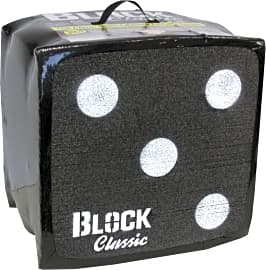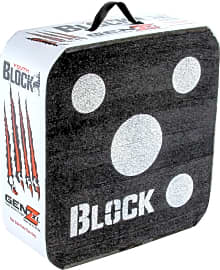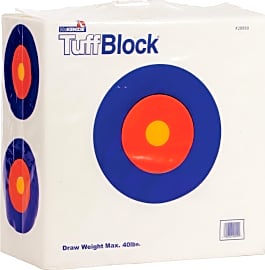The 10 Best Archery Targets

This wiki has been updated 37 times since it was first published in September of 2015. Perhaps in part thanks to "The Hunger Games," archery is enjoying a renaissance of interest among young people. If you have a budding bowman or woman in your family, treat him or her to one of these targets that feature everything from images of deer to traditional bullseyes to help improve their accuracy. They'll help keep practice safe by stopping arrows in their tracks. When users buy our independently chosen editorial selections, we may earn commissions to help fund the Wiki.
Editor's Notes
July 30, 2021:
Because the XL version is no longer available, we've substituted the Rinehart RhinoBlock in the last spot. The rest of the Wiki hasn't changed, including the Rinehart 18-1 Broadhead in the top spot. Of course, it's worth noting that not everyone has the same idea of "best" when it comes to targets, which is why we recommend such a wide variety. On the other hand, if you have your own safe backstop, consider a pack of Longbow 80cm marked targets, which are configured to official specifications.
April 18, 2020:
For this update, we removed the Bear Archery Foam due to its tendency to wear out quickly, and high price point. We replaced it with the Rinehart Rhino XL, a 6-sided box that, while fairly expensive, is built to last. Instead of having to choose between vital organ models, and traditional bullseye targets, this option supplies both. Its replaceable core allows you to continue to use it, even after intense use with broadhead arrows.
No matter the target you choose, always practice strict safety measures during your practice. You should never nock an arrow without being 100% sure of what is in front of your target, what's directly behind it, and far beyond it. A stray arrow can travel much farther than what you can see, especially in wooded areas, so take the time to ensure there is a solid backstop or hill behind your target. It goes without saying that you should never operate your bow while under the influence of alcohol or mood-altering drugs.
In addition to the safety issues, check with your local laws regarding archery target practice. Many states consider a bow to be a weapon, the same as a firearm, and ban the use of any kind of target practice in residential areas.
If you want to increase your accuracy before deer season starts, it's always a good idea to purchase some extra hunting arrows for target practice.
Evolution Of The Archery Target
This is also the source of the round archery targets most common today.
As long as men have had arrows to shoot and bows to shoot them, they have needed archery targets to shoot at. Before the standard Olympic target archery, bowmen participated in range butt shooting, aiming at targets attached to earthen mounds at various ranges up to 150 yards away. The original targets were wooden casks, whose round ends made perfect targets. This is also the source of the round archery targets most common today.
In another form of archery practice called clout shooting, the archery target was a small white piece of canvas, known as a clout or clud, attached to a wooden stake in the ground. In stead of shooting arrows straight for the target, they were shot high into the air to drop down on the target, which laid on the ground rather than standing upright. Modern clout shooters often replace this target with a round archery target at a 45-degree angle.
Genoese bowmen aboard sailing ships would often practice their aim by shooting at a small coin attached to the mast of the ship next to them. This was great for moving target practice, as battling from one ship to another required that archers adjust for not only the motion of their ship, but the motion of the other ship, as well. These impromptu archery targets greatly helped with this.
Unlike their predecessors, modern archers enjoy the luxury of targets made with high density foam, soft plastics, molds, and other synthetic materials that will not only withstand thousands of piercings, but will also easily release arrows from their grasp.
The Ancient Importance Of Archery
Archery has made an impact in many civilizations across the globe. It was the most powerful and useful of the ancient weapons, and this power was often perceived as holy. Perhaps it is this perception which caused archery to be such an important aspect of many ancient cultures.
The Egyptian goddess Neith was actually considered to be a creation deity, and as such, she was androgynous by nature, having both masculine and feminine features. She was both the goddess of war and weaving, and was often seen with either a bow or weaving tools in her hands.
The ancient Roman culture adopted the worship of Apollo from the Greeks, and also heavily favored the bow.
Norse mythology associates archery with deities as well. The great god Odin, known for his fierce love of war and poetry, was a proficient hunter. It is Odin who leads the famed Wild Hunt. His wife Skadi was both the goddess of skiing and the goddess of the hunt. She is often depicted riding through the mountains on skis, shooting wild animals with her bow.
Greek archers sought to emulate the works of various archer deities on Mt. Olympus. Apollo was perhaps the most important of these Olympian deities. Not only was Apollo the god of archery, he was the god of poetry, art, knowledge, medicines, and plagues. Apollo was only four days old when he demanded that Hephaestus create a bow and arrows for him. With these he set out in pursuit of the serpent Python, which Hera had sent to torment his titan mother, Leto.
The ancient Roman culture adopted the worship of Apollo from the Greeks, and also heavily favored the bow. They also explained uncontrollable desire through the creation of the god Cupid. Stemming from the story of the Greek god Eros; a person or deity who is shot by Cupid's arrow is filled with uncontrollable desire. This desire leads both men and gods to terrible folly and misfortune, and Cupid is often seen as an antagonistic character, despite his adorable portrayal in popular culture.
The Land Of The Bow
No civilization was as touched by archery as the Nubians. The Nubian civilization was referred to by ancient Egyptians as Ta-Seti, which literally translates to the land of the bow. The Nubian archers were the backbone around which their civilization was built.
Hunting was the primary means of sustenance for Nubians throughout much of their civilization's history.
Nubian rock art depicts hunters using bows as early as the Neolithic period, over 10,000 years ago. Hunting was the primary means of sustenance for Nubians throughout much of their civilization's history. Everything from food, housing, shelter, and even trade items which brought prosperity were generated by the prowess of Nubian archers.
When Nubian armies competed with Egypt for control over much of the Nile valley, it was archers leading the drive. The skill of Nubian archers was known around the ancient world, and made them valued members of many nation's armed forces. Egyptian texts recorded as early as 2400 B.C.E. note the skill of Nubian archers fighting for Egyptian armies. Figures and images of Nubian bowmen appear in the artwork of all periods of ancient Egyptian history. Many Nubian archers also served in the army of Persia in the first century B.C.E.
As late as the 5th century C.E., burial monuments of Nubian rulers show that they still heavily relied on the bow and arrow. With over nine thousand years of practice as a culture, it is no wonder Nubian elites were considered the best in their class. When Muslim invaders were driven out of Nubian territory in the 8th century, the Muslims themselves noted that it was the accuracy of the Nubian archers that scared them away.















